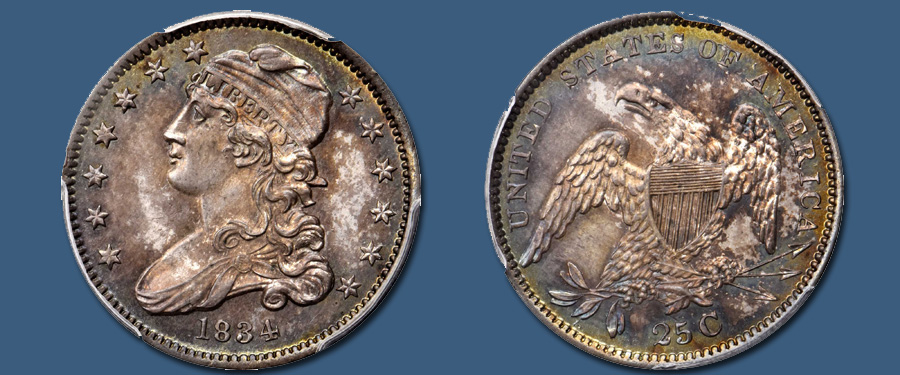
Gem MS-65 (PCGS) 1834 Capped Bust Quarter
The Capped Bust quarter series, struck from 1815 through 1838, is vastly underrated and contains many of the great rarities in 19th century numismatics. Most often collected as part of a type set, examples are readily available in most circulated grades but represent a significant challenge in Mint State preservation. We are thrilled to present an exceptional Gem 1834 B-1, O/F in OF variety quarter in lot 1056 of our May 2019 Baltimore auction.
Certified MS-65 by PCGS, this is a magnificent Gem displaying vibrant rose, turquoise, and golden iridescence across both sides. The fields are lightly prooflike and contrast with the richly frosted design elements. Sharply struck and free from mentionable friction. This is a tremendously important piece for early quarter specialists and ranks as the sole finest example certified by PCGS under this variety.
We most recently offered a Gem example from these dies in our Spring 2019 Baltimore Auction, which realized $11,400 in lot 1060. Just a few years prior we had the pleasure of offering the MS-66* (NGC) Newman specimen in our October 2015 Rarities Auction, where it sold for $26,437 in lot 27.
The Capped Bust quarter series saw some of the most drastic changes ever undertaken by our nation’s coinage. The cornerstone of the second Philadelphia Mint building on Juniper and Chestnut streets was laid on July 4, 1829, by Mint Director Samuel Moore. At around the same time, the Mint, in its existing facility, introduced several technological improvements, chief among which was the close collar (a.k.a. "collar die") which simultaneously imparted reeding to the coins’ edges (when desired) and gave them a uniform diameter. The first coins produced using this innovation were the Capped Bust half dimes of 1829, a denomination not produced since 1805. The first chance to utilize the close collar for the quarter came in 1831, as no examples of this denomination were struck in 1829 or 1830.
To prepare the quarter denomination for close collar production in 1831, Engraver William Kneass modified the existing Capped Bust design by John Reich to allow it to fit onto smaller planchets of uniform diameter. Kneass refined the portrait and eagle, removed the scroll upon which the Latin motto E PLURIBUS UNUM had been inscribed, and added a raised border around both sides. This type has since become known to numismatists as the Reduced Diameter, Reduced Size or, more informally, Small Size Capped Bust quarter. It was produced from 1831 through early 1838. Like its Large Diameter predecessor of 1815 to 1828, this type is among the more underrated in U.S. numismatics. Mint State examples of all issues are far scarcer than generally realized, and they are rare relative to demand. This Gem 1834 is of further interest due to repunching around the letters OF A in the legend, the reverse die previously used to strike the 1833 B-2 O/F in OF variety.
This incredible MS-65 (PCGS) quarter is offered in lot 1056 of our May 2019 Baltimore Auction. The auction is now available for viewing and bidding on our website www.stacksbowers.com, or you may contact our offices to secure a printed catalog. To speak with a numismatic representative, please call 800-458-4646 or email info@stacksbowers.com. Also, download our mobile app to view and participate in our auctions via your Android or Apple device.





